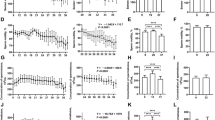Abstract
This study evaluated the extent of oxidative stress by measuring malondialdehyde and ascorbic acid in the seminal plasma of human subjects with different fertility potential. Semen samples from 148 subjects were evaluated (48 normozoospermics, 34 oligoasthenoteratozoospermics, 34 asthenoteratozoospermics and 32 azoospermics). malondialdehyde level was found to be significantly higher in the abnormal groups (oligoasthenoterato and asthenoterato-zoospermics) than normozoospermics (P < 0.01). Negative correlation was also found between malondialdehyde level, sperm concentration, sperm motility and sperm morphology. Level of ascorbic acid was found to be significantly higher in normozoospermics than other abnormal groups (P < 0.01). It was found to be correlated positively with all seminogram parameters and negatively with malondialdehyde level. The study revealed that, excess lipid peroxidation reflected by high malondialdehyde level with reduced ascorbic acid in human seminal plasma is associated with poor semen quality where as ascorbic acid content has positive correlation with fertility potential.
Similar content being viewed by others
References
Halliwell B, Cutteridge JMC. Free radicals, ageing, and disease. In: Free radicals in Biology and Medicine. 2 nded. Oxford University Press. 1989: 123–419.
Sikka Suresh C. Oxidative Stress and role of Antioxidants in Normal and Abnormal Sperm Function. Frontiers in Biosciences 1996; 1: 78–86.
WHO manual for the Standardized investigations, diagnosis and management of infertile couple. Cambridge University Press. Cambridge. 2000; 4th Ed: 8–61.
Agarwal A, Prabakaran SA. Mechanism, measurement, and prevention of oxidative stress in male reproductive physiology. Ind J Exp Biol 2005; 43: 963–974.
Yao-Yuan Hsieh, Chi-Chen Chang, Chich- Sheng Lin. Seminal malonaldehyde concentration but not glutathione peroxidase activity is negatively correlated with seminal concentration & motility. Int J Biol-Sci 2006; 2: 23–29.
Suleiman SA, Ali ME, Zaki ZM, el-Malik EM, Nasr MA. Lipid Peroxidation and human sperm motility: protective role of vitamin E. J Androl 1996; 17: 530.
Geva E, Lessing JB, Bartoov B Lerner-Geva L, Zabludovski N, Amit A. The effect of antioxidant treatment on human spermatozoa fertilization rate in an invitro fertilization programme. Fertil Steril 1996; 66: 430–434.
Song GJ, Norkus EP, Lewis V. Relationship between seminal ascorbic acid and sperm DNA integrity in infertile men. Int J androl 2006; 29: 569–575.
Lutsenko EA, Carcamo JM, Golde DW. Vitamin C prevent DNA Mutations Induced by Oxidative Stress. J Biol Chem 2002; 277(19): 16895–16899.
Thiele JJ, Friesleben HJ, Fuchs J, Ochsendorf FR. Ascorbic Acid & Urate in Human Seminal Plasma: Determination & Interrelationship with Chemiluminescence In washed semen. Human Reproduction 1995; 10: 110.
WHO Laboratory manual for the examination of human semen and sperm cervical mucus interaction. 3rd ed. Cambridge University Press. Cambridge. 1992: 1–107.
McCormick DB, Green HL. Methods for the determination of ascorbic acid. In: Text Book of Clinical Chemistry, 2nd Edn. editted by NW Teitz, WB Saunders Company. 1994; 1313–1314.
Kobayashi T, Jinno M, Sugimura K, Nozaya S, Sugiyama T, Lida E. Sperm morphological assessment based on strict criteria and in vitro fertilization outcome. Hum Reprod 1991; 6: 983–986.
Fraczek M, Szkutnik D, Sanocka D, Kurpisz M. Peroxidation components of sperm lipid membranes in male infertility. Ginekol Pol 2001; 72: 73.
Blumenkrantz N, Calamera JC, Lavieri JC, Mancini RE. Ascorbic acid and metabolically related substances in normal and pathological human semen. Fertil Steril 1967; 18(6): 801–806.
Koets P, Michelson L. Relation between ascorbic acid content and quality of human sperm. Fertil Steril 1956; 7: 15.
Chinoy NJ, Buch RP. Metabolic Significance of Ascorbic acid in Human Semen. Ind J Exp Biol 1977; 15: 921–922.
Rolf C, Copper TG, Yeung CH, Nieschlag E. Antioxidant treatment of patients with asthenozoospermia or moderate oligoasthenozoospermia with high-dose vitamin C and vitamin E: a randomized, placebo-controlled, double blind study. Hum Reprod 1999; 14: 1028–1033.
Dawson EB, Harris WA, Teter MC, Powell LC. Effect of ascorbic acid supplementation on the sperm quality of smokers. Fertil Steril 1992; 58: 1034–1039.
Greco E, Iacobelli M, Rienzi L, Ubaldi F, Ferrero S, Tesarik J. Reduction of the incidence of sperm DNA fragmentation by oral antioxidant. J Androl 2005; 26: 349–353.
Author information
Authors and Affiliations
Corresponding author
Rights and permissions
About this article
Cite this article
Das, P., Choudhari, A.R., Dhawan, A. et al. Role of ascorbic acid in human seminal plasma against the oxidative damage to the sperms. Indian J Clin Biochem 24, 312–315 (2009). https://doi.org/10.1007/s12291-009-0058-2
Published:
Issue Date:
DOI: https://doi.org/10.1007/s12291-009-0058-2




